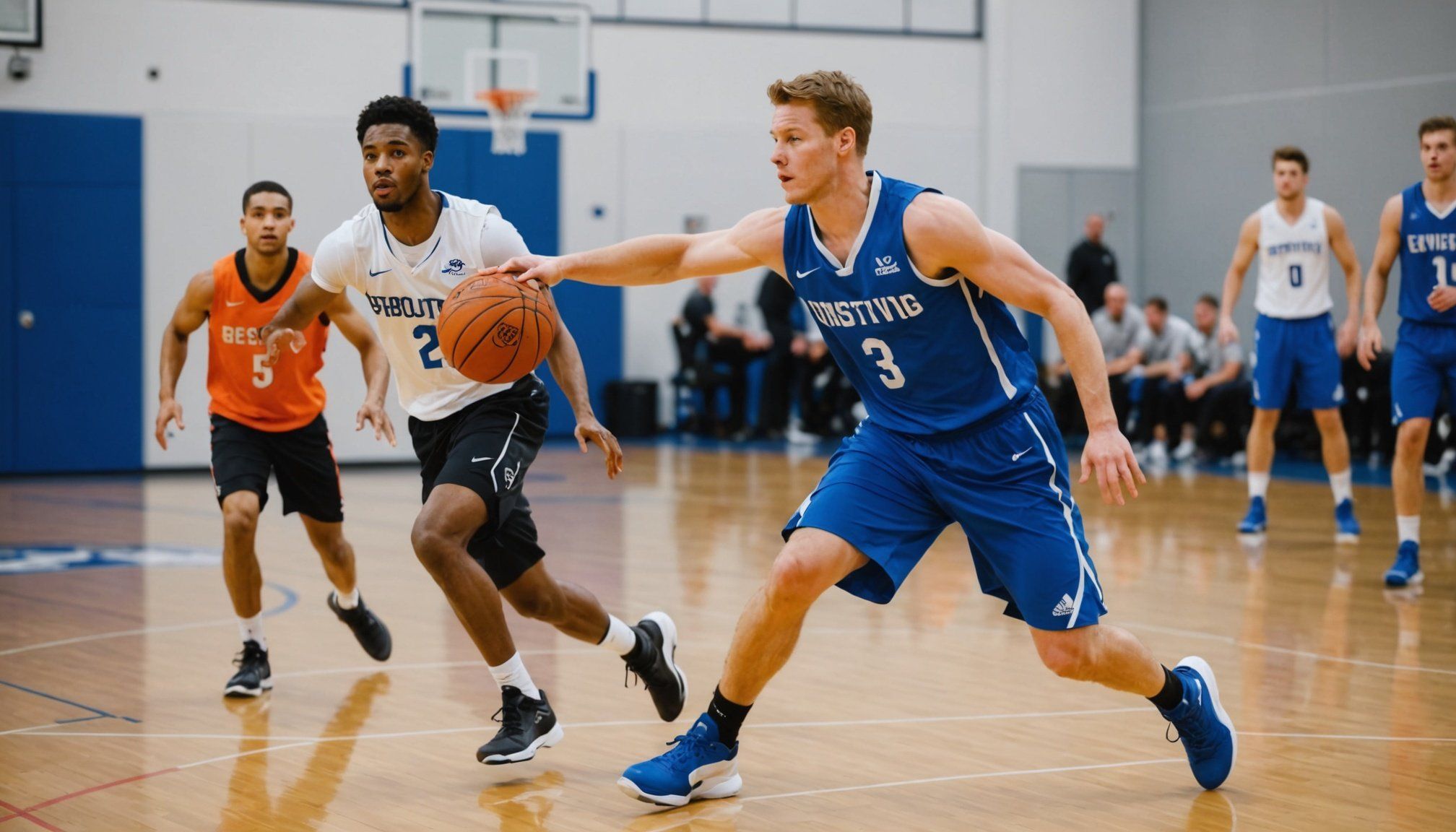Understanding Lateral Movement in Basketball
Lateral movement is pivotal in basketball agility, playing a crucial role in enhancing player performance. It enables quick, multi-directional manoeuvres on the court, essential for both offensive plays like dodging defenders and defensive tasks like blocking shots. The ability to pivot swiftly can set a player apart in terms of efficiency and effectiveness on the court.
Key muscle groups involved in lateral movement, such as the glutes, quads, and calves, provide the power and speed necessary for rapid changes of direction. Strengthening these muscles can significantly contribute to improving a player’s agility and overall court performance.
Agility not only enhances game performance but also plays a significant role in injury prevention. Basketball, with its rapid sprints and abrupt stops, puts considerable stress on a player’s body. Improved basketball agility helps in stabilising the body during such intense movements, reducing the risk of strains and sprains.
Effective lateral movement supports players in maintaining balance, preventing falls, and executing complex plays safely. Investing time to understand and improve this aspect of gameplay can, therefore, yield substantial benefits in terms of both performance enhancement and injury prevention.
Also to discover : Ultimate guide to injury prevention: top cross-training strategies for uk basketball players
Innovative Techniques for Enhancing Agility
Incorporating innovative drills into basketball training can significantly enhance a player’s agility, crucial for executing swift on-court movements.
Plyometric Drills
Plyometric exercises are highly effective in boosting basketball agility. These exercises focus on quick, explosive movements, which are vital in basketball. Examples include box jumps, depth jumps, and lateral bounds. By incorporating these into regular practice sessions, players can improve their lateral movement and speed.
Resistance Training
Resistance training plays a pivotal role in enhancing agility by strengthening key muscles involved in lateral movement. Techniques like lateral band walks and resistance sprints target these areas efficiently. Recommended equipment includes resistance bands and weight vests. These tools help create more dynamic training sessions, fostering player performance improvement.
Dynamic Stretching
Dynamic stretching is essential during warm-ups to prepare the body for intense basketball sessions. Focusing on movements like lateral lunges and side shuffles helps in priming muscles for lateral agility. Integrating these stretches into daily practice ensures players maintain their flexibility and readiness, contributing to sustained performance enhancement and injury prevention. Through structured and targeted training regimens, players can achieve significant gains in agility and overall performance on the court.
Advanced Drills for Coaches
Incorporating basketball drills into coaching sessions is critical for enhancing player performance and agility.
Cone Drills
Cone drills are a staple in training for lateral movement. By setting up a series of cones, coaches can engage players in exercises that mimic game-like conditions. These drills help in developing quick reflexes and boosting agility. Variations such as zig-zag or T-drills challenge players further, refining their ability to change directions swiftly. Monitoring progress through timed runs allows coaches to measure enhancements in speed and agility over time.
Shuttle Runs
Shuttle runs are an excellent tool for advancing basketball training. These drills focus on rapid changes in direction, mirroring the dynamic movements seen on the court. By incorporating shuttle runs into practices, players can improve their quickness and coordination. To cater to different skill levels, coaches can modify distances or adjust the number of repetitions, ensuring each player benefits from the exercise.
Game-Situation Drills
Game-situation drills are designed to bring realism to basketball drills, enhancing player improvement. These exercises simulate actual game conditions, helping players apply agility skills in context. Coaches can use feedback mechanisms, like instant replay, to evaluate and refine player tactics, providing insights that foster continuous development.
Monitoring and Evaluating Player Progress
Thorough player evaluation is integral to assessing gains in basketball agility training. Methods to evaluate performance metrics provide insights into how players enhance their lateral movement. Coaches can implement these evaluations systematically for comprehensive analysis.
Techniques for Assessing Improvements
To effectively measure agility gains, employing timed drills like cone drills or shuttle runs is essential. Precise timing provides clear benchmarks. Tracking consistency over various sessions captures performance improvements, enabling coaches to adjust training programmes accordingly.
Video analysis emerges as a powerful tool, aiding both player evaluation and feedback. Recording players’ movements offers a visual representation of their agility performance. This technique allows coaches to highlight specific areas needing development and showcase tangible progress.
Setting Benchmarks and Goals
Establishing clear benchmarks and goals is crucial for motivating and assessing players. By setting realistic, challenging targets tailored to individual skill levels, players receive motivation and clear direction for improvement. Benchmarks should focus on specific performance metrics, such as speed, balance, and directional change proficiency.
Incorporating training analysis ensures that players and coaches maintain focus on player performance objectives. Regular reviews reinforce accomplishments and highlight areas requiring additional attention. This structured approach fosters continuous development and long-term success.
Additional Resources and Studies
Exploring available basketball research and training resources is crucial for coaches seeking to enhance their team’s performance. Engaging with these materials provides deeper insights into effective strategies and techniques. While specific links are not provided, numerous online platforms offer valuable guides and materials.
For coaches eager to refine their approach, recommended readings include publications focused on agility training and basketball drills. These often present empirical evidence and expert analyses, illuminating how player performance can be optimized. Libraries and sports journals often carry detailed studies that explore cutting-edge coaching techniques.
Additionally, video content available on educational websites or streaming platforms offers visual demonstrations of best practices. These resources can illustrate complex movements, providing both coaches and players with tangible examples of innovative drills and exercises. They can also inform strategies to reduce injury risks while enhancing lateral movement.
By delving into these coaching materials, practitioners can glean new methods and adapt their training programs accordingly. This continual learning process ensures that coaching styles remain both innovative and effective, addressing the evolving demands of modern basketball dynamics.











